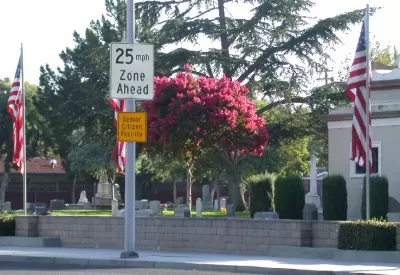A call to action to change the paradigm of planning and development to better serve an aging nation.

Allison Arieff takes a detailed and compassionate look at the housing implications of the country's aging population.
The article begins with a personal anecdote—if this issue isn't personal to you yet, as it is for Arieff, than it will be soon enough. The population aged 65 and over is expected to grow to 79 million from 48 million in the next 20 years. Most communities in the country are not prepared to accommodate the demographic explosion.
Arieff first cites a new report from the Joint Center for Housing Studies at Harvard [pdf], "Projects and Implications for a Growing Population: Older Households 2015-2035 Housing," which "reveals that this demographic shift will increase the need for affordable, safe housing that is well connected to services way beyond what current supply can meet." Supplementing those demographic realities are the facts about where the country is growing, as presented by findings of a new study from the Urban Land Institute's Terwilliger Center for Housing. That study "shows that suburban areas surrounding the 50 largest metropolitan areas in the United States make up 79 percent of the population of those areas but accounted for 91 percent of population growth over the past 15 years (and three-quarters of people age 25 to 34 in these metro areas live in suburbs)."
Thus, Arieff illustrates how decades of development and settlement patterns have left so much of the country's aging population in communities that don't serve their needs.
But suburban homes were originally designed, and for the most part still are, for young families — and for drivers. They are typically surrounded by other single-family houses. Lacking a fitter partner or a network of helpful neighbors and caring family members, older residents can end up feeling isolated, unable to do basic errands or keep up their property.
Then, a call to action: "We’ve got to change this paradigm." More specifically, Arieff argues that urban environments, with their proximity, transit, and density, shouldn't be the only option for seniors, and she has suggestions for how suburban communities can also build a better quality of life for seniors.
FULL STORY: A Housing Crisis for Seniors

Planetizen Federal Action Tracker
A weekly monitor of how Trump’s orders and actions are impacting planners and planning in America.

San Francisco's School District Spent $105M To Build Affordable Housing for Teachers — And That's Just the Beginning
SFUSD joins a growing list of school districts using their land holdings to address housing affordability challenges faced by their own employees.

The Tiny, Adorable $7,000 Car Turning Japan Onto EVs
The single seat Mibot charges from a regular plug as quickly as an iPad, and is about half the price of an average EV.

As Trump Phases Out FEMA, Is It Time to Flee the Floodplains?
With less federal funding available for disaster relief efforts, the need to relocate at-risk communities is more urgent than ever.

With Protected Lanes, 460% More People Commute by Bike
For those needing more ammo, more data proving what we already knew is here.

In More Metros Than You’d Think, Suburbs are Now More Expensive Than the City
If you're moving to the burbs to save on square footage, data shows you should think again.
Urban Design for Planners 1: Software Tools
This six-course series explores essential urban design concepts using open source software and equips planners with the tools they need to participate fully in the urban design process.
Planning for Universal Design
Learn the tools for implementing Universal Design in planning regulations.
Smith Gee Studio
City of Charlotte
City of Camden Redevelopment Agency
City of Astoria
Transportation Research & Education Center (TREC) at Portland State University
US High Speed Rail Association
City of Camden Redevelopment Agency
Municipality of Princeton (NJ)




























